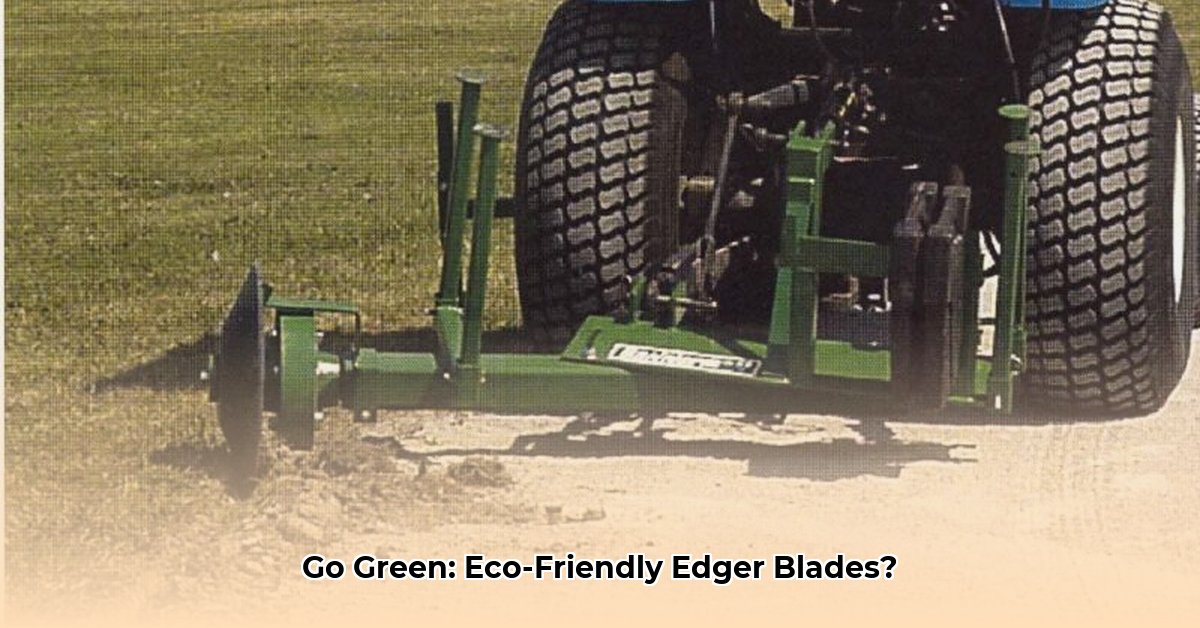
Maintaining a beautiful lawn shouldn't come at the expense of the planet. This guide helps you navigate the world of edger blades, focusing on sustainable choices that minimize your environmental footprint. We'll explore how to select, use, and dispose of edger blades responsibly, offering guidance for both consumers and manufacturers. For durable, sustainable work boots, check out reliable work boots.
Understanding Sustainable Edger Blades: Beyond the Buzzword
"Sustainable" edger blades aren't just a marketing term; they represent a commitment to minimizing environmental impact throughout the product's entire life cycle – from material sourcing to disposal. This includes the materials used (recycled steel is a big plus!), the manufacturing process, and the blade's overall durability.
Standard steel blades are widely available, but their production is energy-intensive and can involve environmentally damaging processes. Recycled steel offers a far greener alternative, lessening the need for resource extraction and reducing energy consumption during manufacturing. However, comprehensive data on the precise environmental impact of different blade materials remains limited. More research, particularly life cycle assessments (LCAs), is crucial to provide a clearer picture. This means more studies are needed to fully gauge the impact. Regardless, a longer-lasting blade is inherently more sustainable, as fewer replacements mean less waste. Isn't that a simple truth we can all agree on?
Choosing Sustainable Edger Blades: A Practical Checklist
Selecting a sustainable edger blade doesn't require expertise. Follow these simple steps:
1. Material Composition: Prioritize blades made from recycled steel or other eco-friendly materials. Check the packaging for clear labeling.
2. Manufacturer Certifications: Look for certifications indicating adherence to sustainable manufacturing practices. While still emerging, expect to see more of these as consumer demand increases.
3. Durability Claims: Read online reviews and look for terms like "heavy-duty" or "rugged" to gauge the blade's longevity. A durable blade means fewer replacements and less waste.
4. Warranty Information: A strong warranty shows the manufacturer's confidence in their product's quality and lifespan. It also provides consumer protection.
5. Sourcing Options: Explore local landscape supply stores, including Tractor Supply, and online retailers that emphasize sustainability. Don't hesitate to ask questions about their sourcing and manufacturing processes! Isn’t it empowering to make conscious choices with your purchasing power?
Using and Maintaining Sustainable Edger Blades: Extending Their Life
Proper care significantly extends your edger blade’s lifespan, directly reducing waste.
1. Regular Sharpening: A sharp blade cuts efficiently, preventing damage and prolonging its usability. A dull blade requires more force, increasing the risk of breakage.
2. Thorough Cleaning: Remove grass clippings and dirt after each use to prevent rust and corrosion.
3. Proper Storage: Store your blade in a dry place (a simple cover works well) to prevent rust and damage.
4. Responsible Disposal: When the blade is unusable, explore local recycling options for metal blades. Dispose of it according to local guidelines if recycling isn't feasible. Did you know that responsible disposal of metal is contributing to the larger goal of circular economy?
For Manufacturers: Embracing Sustainable Practices
Manufacturers hold a key role in creating a more sustainable landscaping industry. Here's how:
1. Comprehensive LCAs: Conduct thorough life cycle assessments (LCAs) to evaluate the environmental impact of every stage of production.
2. Sustainable Material Sourcing: Prioritize recycled and sustainably sourced materials. This significantly reduces the environmental burden of production.
3. Transparent Marketing: Clearly communicate your sustainability initiatives to consumers. This builds trust and meets the growing demand for eco-conscious products. Transparency builds loyalty, and consumers are increasingly looking for this value.
Potential Risks and Mitigation Strategies for Manufacturers
Producing sustainable edger blades presents challenges, but these can be addressed through careful planning:
| Risk Factor | Probability | Impact | Mitigation Strategy |
|---|---|---|---|
| Recycled material scarcity | Medium | Medium | Secure reliable supply chains, explore alternative sustainable materials, and invest in research and development. |
| Higher initial production costs | High | Medium | Explore government incentives, optimize production processes, and focus on economies of scale to reduce long-term costs. |
| Consumer skepticism | Medium | Low | Thoroughly test products, highlight durability and longevity in marketing efforts, build strong brand reputation for commitment to sustainability. |
Conclusion: A Collective Effort for a Greener Future
Choosing and using sustainable edger blades is a small step that adds up to a significant difference. By making informed choices and supporting manufacturers committed to eco-friendly practices, consumers and industry professionals can collectively contribute to a greener future for landscaping. It is all about collective effort, and the reward is a planet that can be more beautiful and healthier for all of us.